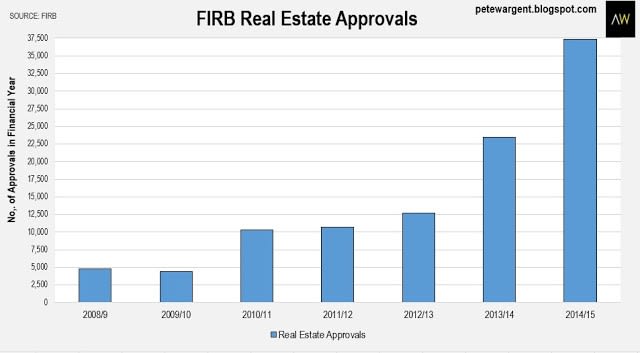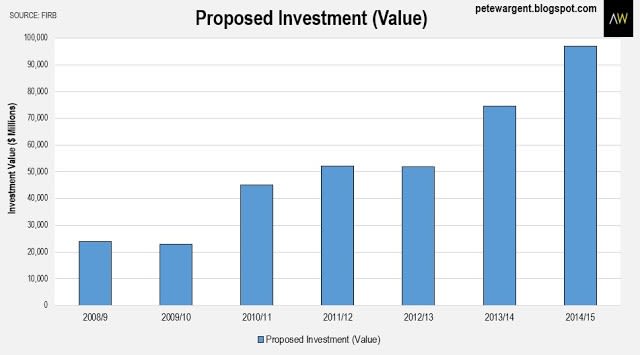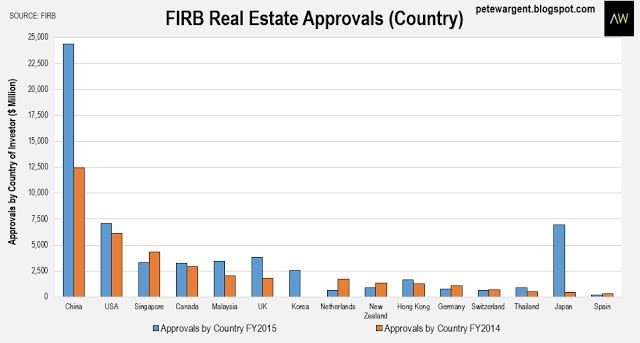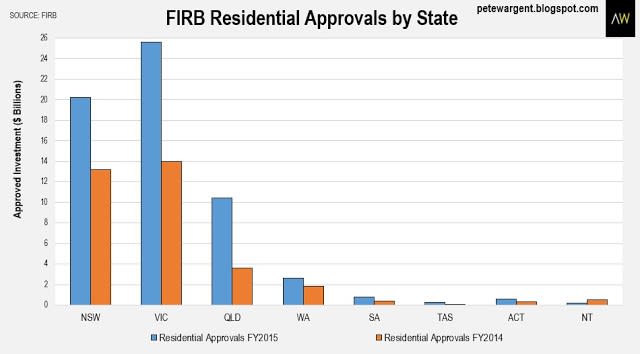FIRB real estate approvals triple in two years: Pete Wargent
It's almost becoming an annual tradition that the Treasury scrambles until 4.59pm on a Friday before pinging out the Foreign Investment Review Board (FIRB) Annual Report and nipping off for a few cold ones.
And this year the finance team surely did not disappoint scrimmaging until mere moments before "schooner o'clock" on Friday before delivering the goods!
Broadly as expected total foreign investment in Australia was very strong in FY2015, increasing by +16.3 percent to $194.6 billion, with real estate (both commercial and residential) the largest sector at $97 billion.
The total number of real estate approvals increased from 23,428 to 37,347 in FY2015, mainly for new dwellings.
Real estate approvals have more than tripled in only two years. Bazinga.

Proposed investment in real estate soared to $96.9 billion, incorporating $36.2 billion of commercial real estate proposals.

Foreign investment in residential real estate
Proposed foreign investment in residential real estate ripped from $34.7 billion in FY2014 to $60.8 billion in FY2015, a level that could even not have been imagined only two years earlier.

No proposals were rejected in FY2015 following three rejections in the preceding year, although 40 percent of approvals were granted with conditions attached, such as time periods for development or the requirement for temporary residents to sell should they depart Australia (approvals are filtered by specific questions, and therefore are to a large degree self-selecting).
One divestment order was made in May 2015 by the FIRB, with an established $39 million residential Sydney property having been purchased illegally by a foreign company.
Thereafter in May last year responsibility for divestment orders was assumed by the Australian Taxation Office (ATO), and a further 26 divestment orders were actioned.
There was a massive 60 percent increase in the number of residential real estate approvals, with about 80 percent of those approvals for purchases of under $1 million in value (i.e. apartments).
The bulk of this monster increase in foreign investment related to new real estate, including developer off the plan purchases, meaning that in aggregate foreign investors accounted for nearly 60 percent of all new residential construction.

China's rise
The value of total FIRB approvals for China has increased by around 68 per cent since the prior year and accounted for around 33 per cent of the total value of approvals by foreign country in FY2015.
Approvals for all Chinese investment in real estate, incorporating residential and commercial investment, all but doubled to $24.3 billion.

Finally, Melbourne retained its crown as the king of foreign investment in terms of residential real estate, reflecting the huge volumes of residential construction in that city, with Sydney comfortably bopped into second place.
There was also enormous foreign investment in vacant land in Victoria at $3.4 billion, far exceeding the $1 billion seen in New South Wales, for example.
The above having been said, Queensland saw far larger increases in foreign residential real estate investment in percentage terms.

The wrap
Foreign investment in Australian residential real estate is something of a double-edged sword.
It is abundantly clear that foreign investors became more active in the purchase of new dwellings in FY2015, and monumentally so, with most of that foreign interest coming from China.
Foreign investment has thus been a crucial factor in the strength of this residential construction boom, accounting for more than half of the investment in new dwellings, helping in turn to keep rental growth subdued.
On the flip side, foreign developers in Sydney have shown a willingness on occasion to pay prices for development opportunities far in excess of what locals are generally prepared to pay, putting significant upwards pressure on land values.
Whether this can level of investment in new dwellings can be sustained is less clear as the residential construction cycle passes its peak imminently.
Clearly there is vast foreign interest in Australian property from China, and it seems reasonable to me to suggest that any holes in the FIRB Annual Report are likely to be errors of omission rather than errors of commission.
As such, the above information acts as a useful indicator, but it may not be complete.
With immigration now rising again, the share of overseas born Aussies at a 120 year high, and as the number of international students in Australia skyrockets, the potential pathways for foreign capital to ultimately find its way into established residential property markets are multiplying, particularly in the largest capital cities.
A final thought or question for you - what percentage share of these new apartments bought by investors from the Chinese mainland ever make it to the local rental market?
A final thought or question for you - what percentage share of these new apartments bought by investors from the Chinese mainland ever make it to the local rental market?
PETE WARGENT is the co-founder of AllenWargent property buyers (London, Sydney) and a best-selling author and blogger.
His latest book is Four Green Houses and a Red Hotel.
Pete Wargent
Pete Wargent is the co-founder of BuyersBuyers.com.au, offering affordable homebuying assistance to all Australians, and a best-selling author and blogger.
